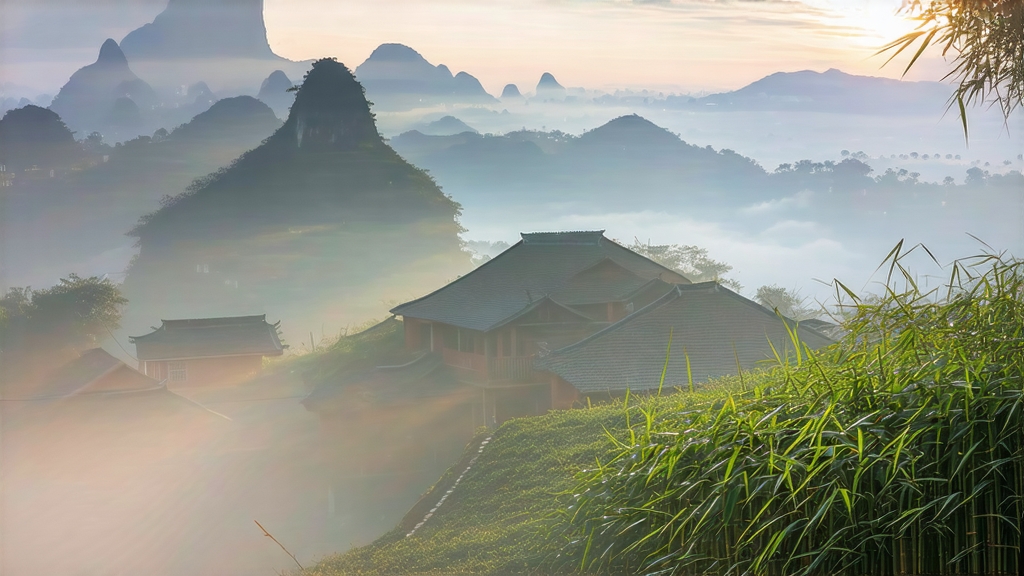
Tucked into the creases of Guangxi’s subtropical mountains, Liupu tea (often written Liu Bao) is the quietest celebrity of China’s dark-tea family. While Pu-erh hoards the limelight, Liupu has spent four centuries maturing in caves, bamboo baskets, and the holds of junks that once carried it to Southeast Asia on the Pearl River. The name simply means “Six Forts,” a nod to the six ancient stockades that guarded the mountain pass outside Wuzhou. There, cool mist, mineral soil, and a riverine microclimate conspired to create a tea that Chinese dock-workers once called “medicine for sailors” and that Malay tin miners brewed thick enough to stain porcelain black.
Liupu is not a single recipe but a continuum of flavors stretched across time. At one end sit the lightly fermented “qing zhuan” bricks pressed in the 1980s—still greenish at the core, smelling of pine sap and dried longan. At the other extreme are the 1950s “hong zhuan” bricks auctioned in Hong Kong for the price of a compact car, their leaves almost ebony, exhaling camphor, betel nut, and the earthy sweetness of petrichor after monsoon. Between these poles lies every shade of rust, mahogany, and ink, each vintage stamped on the bamboo husk wrapper in fading indigo: the weight, the factory code, and the reign-year of the Guangxu Emperor if the brick is old enough to vote.
Making Liupu is a dialogue between fire, water, and gravity. The day after Qingming, pickers climb to 600 m and snap the standard “one bud three leaves,” thick enough to survive what comes next. The leaves are briefly withered under mountain wind, then wok-fired at 280 °C for eight minutes—just long enough to kill the green enzymes while preserving the leaf’s spine. Rolling follows, a tight spiral twist that bruises the edges so oxidative juices bleed to the surface. But the critical inflection is the “wo dui,” the wet-pile fermentation invented here three centuries before Pu-erh borrowed it. The tea is piled 70 cm high inside spotless cement rooms, misted with mineral water drawn from the Liupu spring, and covered with jute sacks. Inside this composting core the temperature climbs to 58 °C; thermophilic microbes bloom, converting catechins into theaflavins and theabrownins, painting the liquor its signature ox-blood red. Every two days the pile is turned by barefoot workers who judge readiness by aroma: when the sweet rot of jackfruit gives way to the cool scent of wet slate, the tea is spread out to dry. Finally the leaves are steamed soft, packed into cylindrical bamboo baskets lined with palm leaves, and pressed under stone weights for a fortnight. The baskets are then moved to limestone caves—natural cellars where humidity hovers at 85 % and temperature drifts between 18 and 22 °C year-round. There Liupu sleeps, breathing through the bamboo, slowly oxidizing and re-absorbing the cave’s mineral breath. A decade inside can shave off the rough edges; three decades can turn the tea into liquid antique.
To brew Liupu is to negotiate with history. A 1990s basket tea demands respect but no reverence: 5 g of leaf, a 150 ml Yixing pot seasoned only with dark teas, and water just off a rolling boil. The first 10-second rinse awakens the compressed leaf and rinses away the dust of decades. Pour it away, but cup your hands over the steaming pot: the aroma is the overture—betel pepper, camphor, maybe a whisper of salted plum. The first proper infusion, 15 seconds, releases a liquor the color of Château Margaux. Sip noisily, aerating the tea across the palate: front is silky, mid-palate carries a dark-honey sweetness, finish returns with the cooling snap of menthol. By the fifth infusion the leaf has fully unfurled; lengthen the steep to 40 seconds and notice how the sweetness migrates to the back of the tongue, leaving a hollow at the front like the echo in a cave. A good Liupu yields ten infusions; a great one, fifteen. When the session ends, chew a spent leaf: it should feel like tender spinach, proof that the tea was neither over-fermented nor baked dry.
Tasting Liupu is only